

How your behaviour in childhood predicts whether you’ll be in a relationship as an adult. The question of how to find a steady romantic partnership is among the oldest human predicaments.
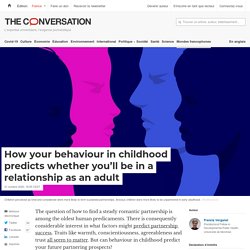
There is consequently considerable interest in what factors might predict partnership success. Traits like warmth, conscientiousness, agreeableness and trust all seem to matter. But can behaviour in childhood predict your future partnering prospects? In a new study published with my colleagues in Journal of Child Psychology and Psychiatry we show that children rated by their elementary schoolteachers as being anxious or inattentive were more likely to remain unpartnered from age 18 to 35 years.
Families can support kids' mental health whether they're learning remotely or at school – here's how. The choice between in-person learning, where available, and remote learning is a fraught one for parents.
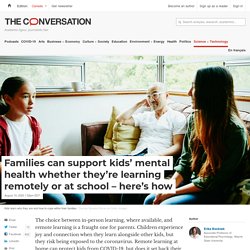
Children experience joy and connection when they learn alongside other kids, but they risk being exposed to the coronavirus. Remote learning at home can protect kids from COVID-19, but does it set back their social-emotional development? It may feel like a stark choice between mental or physical health. But as a family therapist and professor of educational psychology who studies resilience in families under stress, I can assure you there’s no single schooling option that guarantees a happy, healthy kid or dooms a child to despair. In fact, much more than schooling context, children’s mental health relies on high-quality relationships within families.
Spending time with other children can benefit children’s mental health, though it’s not clear that group settings are necessary to achieve those gains. Connecting mind and body: ‘What I need’ This guidance applies across ages. Untitled. Opinion —iStock/Getty Images Plus By Mary M.
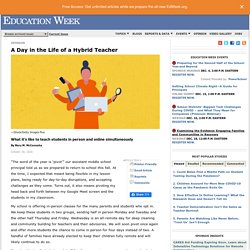
McConnaha. Anatomi Essay Penerima Beasiswa CCIP. Beasiswa CCIP atau Community College Initiative program adalah beasiswa global yang diberikan oleh Pemerintah Amerika.
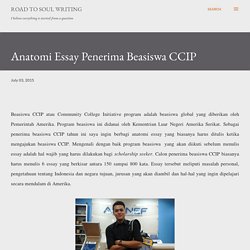
Penjelasan dan Contoh Essay CCIP 2018 - Defir (Dede Firmansah) Penjelasan dan Contoh Essay CCIP 2018 - Defir (Dede Firmansah) Assalamualaikum.
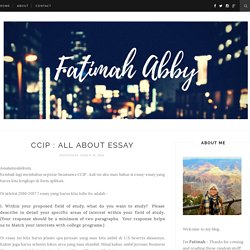
Penjelasan dan Contoh Essay CCIP 2018 - Defir (Dede Firmansah) My last two job were with Philips and 4Life Indonesia.

When I was in Philips. I work as a Retail Store Promoter which was pretty much the same with Customer Service job. I talked with so many people, handling their complaints and also provide the best solution. I have big eagerness to learn about others background, culture, and point of view. Penjelasan dan Contoh Essay CCIP 2018 - Defir (Dede Firmansah) Pengalaman Beasiswa Community College Initiative Program (CCIP) 2012: Menjawab Esai – Nasi Ramas. Formulir aplikasi beasiswa Community College Initiative Program (CCIP) ini adalah “tiket” saya untuk diundang interview oleh Aminef di Jakarta.

Untitled. “Success is where preparation and opportunity meet.” - Bobby Unser.
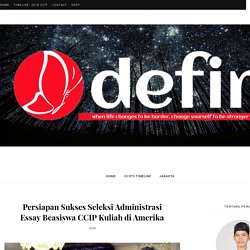
Untitled. Untitled. Ulasan Lengkap Membedakan Legal Aid dan Pro Bono.

Untitled. Untitled. Untitled. Safety for children. Nia course outline. Communication and Language: Listening and Attention. Community Playthings. Heuristic play is rooted in young children’s natural curiosity. As babies grow, they move beyond being content to simply feel and ponder objects, to wanting to find out what can be done with them. Toddlers have an urge to handle things: to gather, fill, dump, stack, knock down, select and manipulate in other ways.
Household or kitchen utensils offer this kind of activity as every parent knows, and can occupy a child for surprising stretches of time. When toddlers make an enjoyable discovery – for instance when one item fits into another, or an interesting sound is produced – they often repeat the action several times to test the result, which strengthens cognitive development as well as fine muscle control and hand/eye coordination. In their book, People under Three, Elinor Goldschmied and Sonia Jackson coined the term heuristic play, to explain how to provide a more structured opportunity for this kind of activity. Heuristic play with objects is not a novel idea.
Practicing Save and Return for parents to maje the bilingual children comfortable. How Caregivers Can Boost Young Brains. Adapted from research by the Center on the Developing Child at Harvard University and from resources developed by Filming Interactions to Nurture Development.
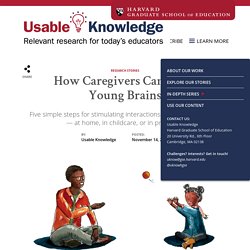
When adults react and respond to young children’s babbles, gestures, and cries, they are doing more than providing good, nurturing care. They're actually laying the groundwork for children's future growth and development — helping to build the neural connections in the brain that support communication and social skills. Ordinary back-and-forth interactions between a caregiver and child — called "serve and return" — can shape brain architecture in powerful ways, creating a strong foundation for future learning. Here are five simple ways for parents, childcare providers, and early educators to practice these interactions.
The Power of Evening Routines. The word “structure” can evoke less than positive associations. It suggests constraints, which are never a good thing, right? Wrong. It turns out that everyone benefits from a certain amount of daily structure, so long as that structure is pleasant, productive, and meaningful. Whether it’s the most inventive minds in history, or those people who live in good health past 100, a daily routine or set of micro-routines is correlated with productivity, health, and longevity. How do you speak 'Motherese'? The Woman Who Changed Her Brain: Barbara Arrowsmith-Young at TEDxToronto. How baby brains develop. Early childhood development – it’s not rocket science, it’s neuroscience!
I was introduced to Mine Conkbayir when she contacted me about neuroscience informing early years practice, which I think is such an exciting, and growing, area of study. So I was very enthusiastic when she offered to do a guest post on this subject. Here she discusses how neuroscience can add another dimension to our understanding of child development: Like many individuals in this increasingly frantic world, I’m often busy juggling my responsibilities as a parent while I work and continue my studies – a very exciting journey as I try to achieve my PhD in early childhood education and neuroscience. Having been a lecturer across a range of child care and education qualifications for the past 14 years, I continue to be bewildered by the lack of consistently embedded teaching of neuroscience and early brain development across these qualifications. Listen to Your Mother. Young children face a remarkable challenge in learning to use the language of their culture.
Toddlers vary widely, however, in the rate at which they learn new words.1 A team of Harvard Graduate School of Education researchers set out to ask whether and how children's language environment can impact vocabulary development. In their study of mother-child pairs from low-income families, they found that mothers who used many different words (not just many words) had toddlers with faster growth in vocabulary use. Deb Roy: The birth of a word.
FAQ: Raising Bilingual Children. Why want bilingual children? There are many reasons, but the two most common are: 1) The parents speak different languages (say, an American woman and a Turkish man). 2) The parents speak the same language, but live in a community where most people speak something else (say, a Korean couple living in the USA). Being Multilingual: You speak with an accent. I don’t. Accents are things that only other people have. They are, by extension, things that you don’t want to have.
Accents are, in short, shortcomings. Why does my toddler love repetition? Paediatric speech and language therapist. Let's Talk. What do babies need in order to learn and thrive? One thing they need is conversation — responsive, back-and-forth communication with their parents and caregivers. This interactive engagement is like food for their developing brains, nurturing language acquisition, early literacy, school readiness, and social and emotional well-being. A dispiriting number of children don’t get that kind of brain-fueling communication, research suggests. In early childhood policy (and in the wider media), much attention has been paid to the so-called word gap — findings that show that low-income children hear 30 million fewer words, on average, and have less than half the vocabulary of upper-income peers by age three.
But putting that alarming number in the spotlight obscures a more critical component of the research, says Harvard Graduate School of Education literacy expert Meredith Rowe: it’s not so much the quantity of words but the quality of the talk that matters most to a child’s development. Multilingual Preschoolers. It’s amazing how young children learn to converse with others.
They have to not only internalize grammar and vocabulary, but also develop an understanding of culture: how to take turns in a conversation, who to talk to, and how to narrate a story. For dual language learners (DLLs) — children under the age of 5 with a home language other than English — that process can be complex. These young children must constantly navigate between two languages and cultures, while learning the rules of both. How can I help my child to start talking? (Video) Health visitor Sara Patience describes how you can help develop your child's language skills by talking and playing with her.
Show transcript Hide transcript.